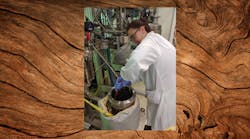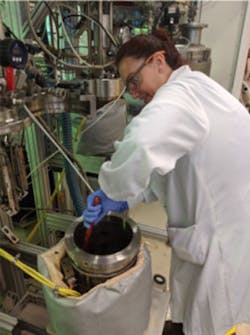Research teams at Lawrence Berkeley and Sandia National Laboratories have jointly develop a streamlined and efficient process for converting woody plant matter, such as forest overgrowth and agricultural waste—material that is currently burned either intentionally or unintentionally—into liquid biofuel. Until now, wood has been difficult to chemically break down.
The teams found that commercially available enzymes, which are non-toxic, can be combined with a specially engineered strain of yeast along with wood in a single container or “pot,” to make ethanol. Using a single reactor lets the process use less water and energy. The work is the first-ever end-to-end process for ethanol production from woody biomass featuring both high conversion efficiency and a simple one-pot configuration.
Technological and economic analysis helped the teams identify the improvements needed make ethanol from the new production process at $3 per gasoline gallon equivalent.
The process presents several opportunities. “Removing woody biomass from forests, such as overgrown pines of the Sierra, and from agricultural areas such as almond orchards of California’s Central Valley, we can address several problems at once: disastrous wildfires in fire-prone states, air pollution hazards from controlled burning of crop residues and our dependence on fossil fuels,” says Lalitendu Das, a postdoc fellow at Sandi and the Joint BioEnergy Institute (JBEI). “On top of that, we would significantly reduce the amount of carbon added to the atmosphere and create new jobs in the bioenergy industry.”
Ethanol is already used as an emissions-reducing additive in conventional gasoline, typically constituting about 10% of the gas used in cars and trucks in the U.S.
Ethanol derived from plant biomass can also be used to make more complex diesel and jet fuels, which are helping decarbonize the difficult-to-electrify aviation and freight sectors. Currently, the most common source of bio-based ethanol are corn kernels, a starchy material much easier to break down chemically, but which takes land, water, and other resources to produce.
The teams found that woody biomass can be efficiently broken down and converted into advanced biofuels in a process that is cost-competitive with starch-based corn ethanol. The process can also turnout “drop-in” biofuels chemically identical to compounds already in gasoline and diesel fuel.
One benefit of the new process is that it would reduce the amount of dry wood that accumulates over the years and increases the risks of wildfires. “According to a recent report, by 2050 there will be 38 million tons of dry woody biomass available each year, making it an exceptionally abundant carbon source for biofuel production,” says Carolina Barcelos, an engineer at Berkeley Lab’s Advanced Biofuels and Bioproducts Process Development Unit.
The next steps in this effort are to develop, design and deploy the technology at the pilot scale, which is defined as a process that converts one ton of biomass per day. The Berkeley Lab teams are working with Aemetis, a renewable fuel and biochemicals company that wants to commercialize the technology and launch it at larger scales once the pilot phase is complete.

